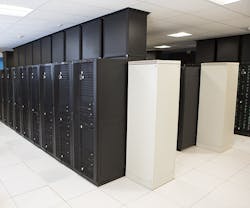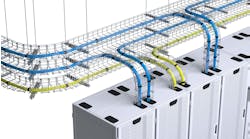How Anthem Transformed its Legacy Data Center into a Model of Efficiency
In this edition of Voices of the Industry, Chatsworth Products’ John Thompson explores how Anthem, one of the largest healthcare companies in the country, transformed and modernized their legacy data center.
John Thompson, Field Applications Engineer, Chatsworth Products
Anthem, Inc., the second largest managed health care company in the United States, operates four primary data centers. The largest is located at its corporate headquarters in Richmond, Virginia. This particular data center supports office spaces and numerous companywide business applications. The information technology (IT) staff, in partnership with facilities management, has carefully managed growth, but over time, found themselves facing higher energy costs and a growing dissatisfaction with their current equipment infrastructure provider.
Research and Planning
The Richmond data center is 58,000 square feet (5388.3 square meters) and uses a traditional open air, hot aisle/cold aisle airflow strategy. Even though the data center uses only 10 percent of the building’s overall square footage, it generates more than 82 percent of its electricity costs. In today’s competitive market, such costs must be evaluated and improved, wherever possible.
Would it be possible to make dramatic improvements in such a large, established legacy data center? Dean Wagstaff, Director of Data Center Operation, believed it was. With 30 years of experience in data center operations, Dean knew of several strategies for reducing energy use, but wanted to be sure to choose the best approach.
Wagstaff used a combination of field research, data analysis and on-site assessment to evaluate an airflow management and containment strategy. “I wanted to get away from opinions. I needed data-driven results,” said Wagstaff. “Requirements for space and power are easy to see, but cooling is more difficult. The models provided a visual illustration. It takes everything into consideration and tells the story, allowing us to justify the changes.”
The research and planning phase included the following steps:
- Field research: Wagstaff took advantage of his professional network to visit a state-of-the-art data center nearby, observing the performance of airflow management and containment in a similar scale facility.
- Data analysis: Computational Fluid Dynamics (CFD) models illustrating Anthem’s current data center, as well as illustrations of a remodeled data center using airflow containment provided Anthem with the data-driven results needed to justify the changes.
- Evaluation: Wagstaff worked closely with an Information and Communications Technology distributor partner to order and evaluate data center cabinets and power products from several manufacturers. Then, he and his team analyzed the feedback from key employees who would be using those products daily.
Solution approach
Wagstaff and his team decided to partner with the same manufacturer they saw in the data center they had visited in the early phase of the project, because of its expertise and attention to detail. Two principal strategies that would help Anthem achieve its efficiency and energy goals were identified:
- Improvements in a large, established data center requires focus on the cabinet and on the data center as a whole, so the solution would include airflow containment at the cabinet and aisle level, and accessories such as raised floor grommets and filler panels.
- Improvements with cooling and substantial savings can be realized with cooling upgrades. The existing Computer Room Air Handlers (CRAHs) units, which were operating at 100 percent capacity, were replaced with newer, more efficient models operating at 50 percent. The illustrations below show the difference in associated cooling energy and costs the old CRAHs operating at 100 percent (Figure 1) vs the new CRAH’s operating at 50 percent (Figure 2).
- Chiller energy is based on the following chart (Figure 3) which is published in the ASHRAE- Best Practices for Datacom Facility Energy Efficiency – 2nd Edition, p. 40.
Figure 1
Figure 3
Execution/Implementation
The path to improvement began with a complete containment strategy at the cabinet and the aisle level. It was recommended that Anthem raised chiller water temperatures from 42 ˚F to 62 ˚F when possible and replace and upgrade CRAHs with Variable Frequency Drives (VDFs).
The main solutions included:
- Aisle-level containment: To fully realize savings and improve chiller efficiencies, complete airflow containment was critical. At the aisle level, Anthem deployed a field-fabricated, customizable Hot Aisle Containment (HAC) solution, which included doors to seal the ends of hot aisles and an overhead duct to separate hot air and cold air in the room. This solution is perfect for retrofit deployments because it integrates with perimeter cooling, it is compatible with economization methods and fits over a mix of cabinets of varying heights, widths or depths.
- Cabinet-level containment: The cabinet solution included a robust server cabinet with Vertical Exhaust Duct. The Vertical Exhaust Duct, which looks like a chimney above the cabinet, guides hot exhaust air out of the cabinet, providing equipment with the hot/cold air isolation necessary for efficient operation.
- Intelligent power distribution: In preparation for future needs, Anthem installed monitored power distribution units (PDUs) to gain access to continuous monitoring of voltage, current, power and power-factor measurements for total PDU usage. Although they haven’t been fully deployed yet, these intelligent PDUs will also save Anthem thousands in networking costs due to robust IP consolidation and failover capability that uses only two networking ports for up to 32 PDUs.
- Data Center Infrastructure Management (DCIM): It’s also in future plans to fully deploy a DCIM software to track and trend power, temperature and humidity and to track assets. This insight—when combined with solid cabinet ecosystem will contribute to even higher levels of operational efficiency.
Conclusions
The combination of a well thought out containment strategy and replacement of CRAHs has enabled Anthem to operate the CRAHs at 50 percent, rather than the previous 100 percent—saving thousands annually. The new air handlers with VFDs are saving energy while working in concert with a slow, upward migration of the chilled water temperature.
This increase, coupled with the increased supply air temperatures made possible by the complete air containment, continue the domino effect in savings and efficiencies.
Ongoing journey
Anthem’s partnership with the data center manufacturer continues. The CFD models are updated twice a year to confirm successes so that Anthem’s IT staff can plan next steps—one cabinet at a time.
Since joining Chatsworth Products over 10 years ago John Thompson, CPI’s thermal expert, has assisted in the design of both new and existing data centers ranging in size from just a few cabinets to many hundreds of cabinets.





